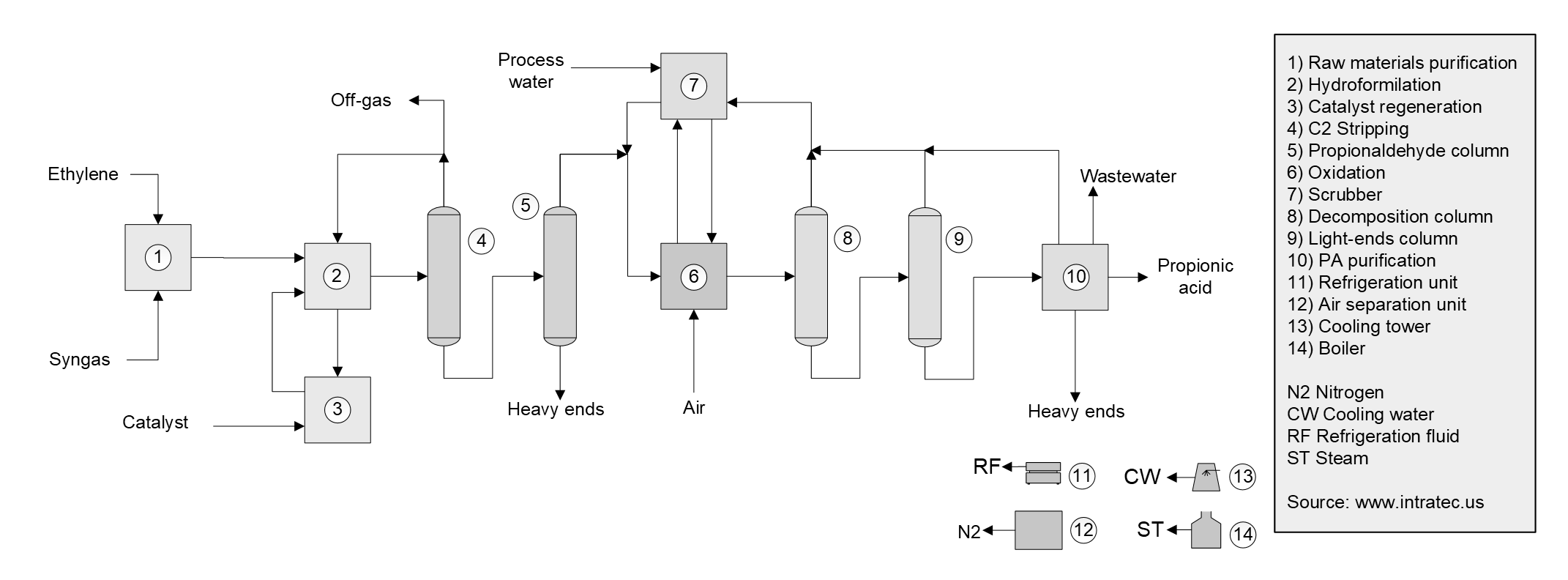Commodity Production Costs Report
Propionic Acid Production from Ethylene
Propionic Acid Plant Capital & Operating Cost Analysis | United States | Q3 2025
This report presents the economics of Propionic Acid production from ethylene and synthesis gas. In this process, propionaldehyde is formed by ethylene hydroformylation, and then converted to Propionic Acid via an oxidation reaction.
The report provides a comprehensive study of Propionic Acid production and related Propionic Acid production cost, covering three key aspects: a complete description of the Propionic Acid production process examined; an in-depth analysis of the related Propionic Acid plant capital cost (Capex); and an evaluation of the respective Propionic Acid plant operating costs (Opex).
The Propionic Acid production process description includes a block flow diagram (BFD), an overview of the industrial site installations, detailing both the process unit and the necessary infrastructure, process consumption figures and comprehensive process flow diagrams (PFD). The Propionic Acid plant capital cost analysis breaks down the Capex by plant cost (i.e., ISBL, OSBL and Contingency); owner's cost; working capital; and costs incurred during industrial plant commissioning and start-up. The Propionic Acid plant operating costs analysis covers operating expenses, including variable costs like raw materials and utilities, and fixed costs such as maintenance, labor, and depreciation.

The process under analysis comprises four major sections: (1) ethylene hydroformylation; (2) propionaldehyde separation; (3) propionaldehyde oxidation; and (4) Propionic Acid separation.
* Ethylene hydroformylation. Syngas and ethylene are initially passed through a purification step to remove catalyst poisons. In the hydroformylation, ethylene reacts with carbon monoxide and hydrogen at mild temperatures and low pressures in the presence of a homogeneous rhodium based catalyst with an organophosphine ligand, yielding propionaldehyde. The reaction takes place in a jackted stirred-tank reactor.
* Propionaldehyde separation. The effluent from hydroformylation is passed through a condenser and a flash separator and subsequently fed to a stripping column for separation of aldehyde from unreacted raw materials. The aldehyde-rich stream is sent to a second column, where propionaldehyde is separated from heavy impurities.
* Propionaldehyde oxidation. The propionaldehyde generated upstream is fed to three tube and shell reactors operating in series, where it is oxidized to Propionic Acid under mild pressures in the liquid phase in the presence of air. Crude acid taken off at the bottom of the last reactor is routed to separation and purification steps downstream.
* Propionic Acid separation. The crude acid is fed to a decomposition column, where perpropionic acid contaminant is decomposed by heating under a positive nitrogen pressure. Then, unconverted propionaldehyde is recovered in a subsequent column and recycled to the oxidation reaction. The rich Propionic Acid stream is routed to a light-ends column for the removal of light impurities and high purity Propionic Acid (99.5 wt%) is finally obtained by azeotropic distillation using ethyl acetate as entrainer.
Report in PDF Format
Download & Explore Anytime
Access in Various Devices
Print & Read Comfortably
Share With Co-workers
Up-to-date Report
Professional report based on Q3 2025 economic data, ensuring timely evaluations.
Multiple Use Cases
Ideal for investment screening, feasibility studies, cost estimates, and research planning.
Proven Methodology
Developed using a consistent methodology honed over a decade, ensuring reliable cost analyses.
Report Editions
Content Highlights
Plant Capital Cost Summary
Summary outlining the capital cost required for building the Propionic Acid production plant examined.
Plant Capital Cost Details
Detailing of fixed capital (ISBL, OSBL & Owner’s Cost), working capital and additional capital requirements.
Plant Cost Breakdowns
Breakdown of Propionic Acid process unit (ISBL) costs and infrastructure (OSBL) costs; plant cost breakdown per discipline.
Operating Costs Summary
Summary presenting the operating variable costs and the total operating cost of the Propionic Acid production plant studied.
Operating Cost Details
Detailing of utilities costs, operating fixed costs and depreciation.
Plant Capacity Assessment
Comparative analysis of capital investment and operating costs for different Propionic Acid plant capacities.
Production Process Information
Block Flow Diagram, descriptions of process unit (ISBL) and site infrastructure (OSBL).
Process Consumptions
Raw materials and utilities consumption figures, by-products credits, labor requirements
Process Diagrams
Process flow diagrams (PFD), equipment list and industrial site configuration
Other Propionic Acid Production Cost Reports

Propionic Acid Production from Propionaldehyde
This report presents the economic analysis of Propionic Acid production from propionaldehyde (i.e. propanal). In this process, propionaldehyde is subjected to a oxidation reaction that generates Propionic Acid product. The economic analysis presented is based on a plant constructed in the United States.
Details: 80 kta United States-based plant | Q3 2025 | 107 pages | Issue B | From $999 USD
Bundle & Save
Purchase multiple Propionic Acid Production Cost reports and enjoy tiered discounts
up to 10% off!
Could Not Find the Report You Need?
Obtain a Bespoke Report
Get a report targeting the process in which you are interested
See Offer Details
Understand Bespoke Reports and how you can easily order them
Check Editions & Pricing
Complete a brief form and see a quotation for your Bespoke Report
Other Related Production Cost Reports

Ethylene Production from Ethane
This report presents the economics of Polymer Grade (PG) Ethylene production from ethane in the United States. In the process under analysis, ethane is thermally cracked in pyrolysis furnaces through the use of steam, yielding Ethylene. A hydrogen-rich gas is generated as by-product.
Details: 1200 kta United States-based plant | Q3 2025 | 107 pages | Issue B | From $799 USD

Ethylene Production from Naphtha (Low Severity Steam Cracking)
This report presents the economics of a naphtha-based steam cracker, equipped with an electricity cogeneration unit. In this process, naphtha is thermally cracked at low severity conditions, maximizing propylene to Ethylene ratio. The analysis is based on a plant located in Germany.
Details: 800 kta Germany-based plant | Q3 2025 | 107 pages | Issue A | From $799 USD
+800 Reports Developed, Targeting +250 Commodities
Vast Report Library
858 independent and up-to-date reports examining embryonic and established production processes.
Free Sample Reports
Quickly understand the structure and depth of content of our professional reports.

